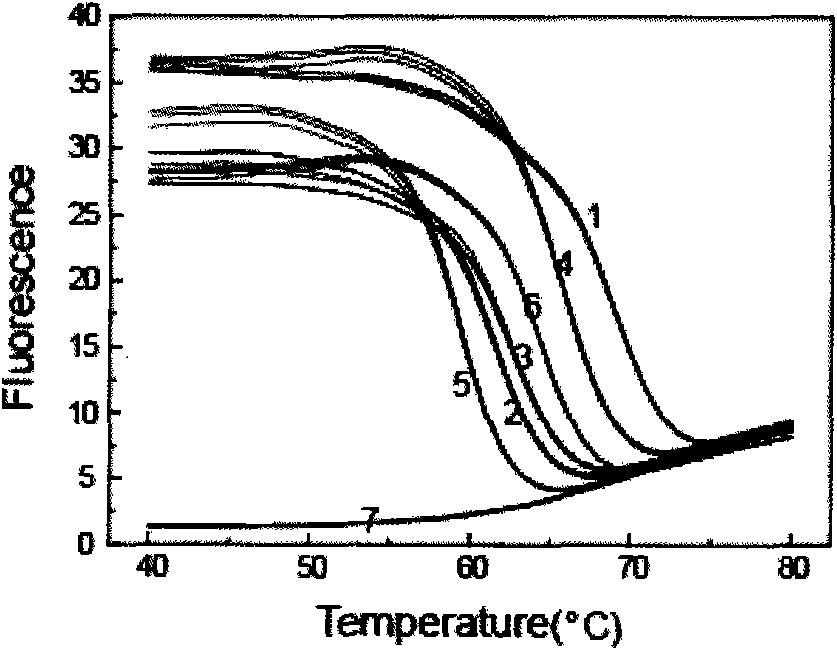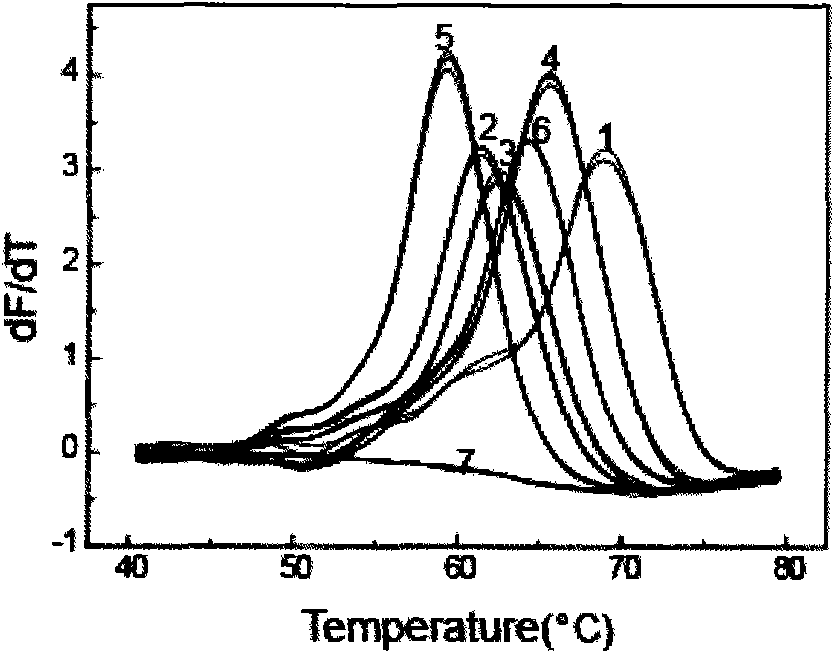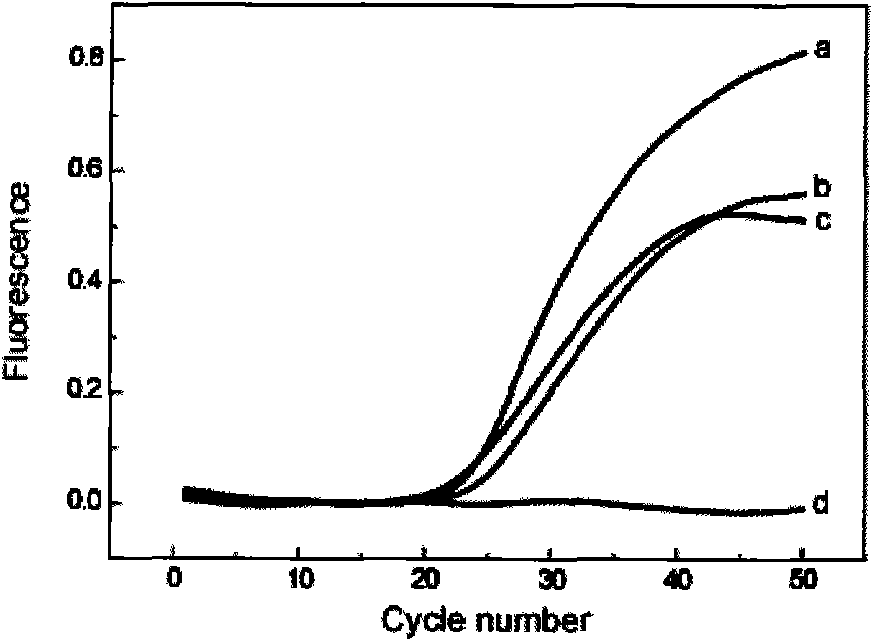Method for detecting human beta-globin gene mutation
A globin and human detection technology, applied in biochemical equipment and methods, microbial determination/inspection, fluorescence/phosphorescence, etc., can solve the problem of difficulty in simultaneous detection of multiple beta-globin gene mutations, cumbersome operations, and low throughput and other problems, to achieve the effect of saving reagents and costs, not easy to contaminate, and easy and fast to operate
- Summary
- Abstract
- Description
- Claims
- Application Information
AI Technical Summary
Problems solved by technology
Method used
Image
Examples
Embodiment 1
[0069] Example 1 Artificially synthesizing different complementary target sequences to investigate the ability of the improved molecular beacon melting curve method to detect mutations in the β-globin gene
[0070] In this example, an improved molecular beacon targeting the TATA box in the promoter region of the β-globin gene was designed, wild-type and target sequences with different point mutations were artificially synthesized, and the improved molecular beacon melting curve method was used to detect β-globin gene mutations Ability. The sequences of the modified molecular beacons and targets used were:
[0071] Probe 1: 5′-FAM-C GGC TGGGCATAAA AGTCAGGGC CG-BHQ-3′
[0072] Target 1: 5′-GCTGCCCTGACTTTTATGCCCAGCCCTG-3′
[0073] Target 2: 5′-GCTGCCCTGACTTCTATGCCCAGCCCTG-3′
[0074] Target 3: 5′-GCTGCCCTGACTTTCATGCCCAGCCCTG-3′
[0075] Target 4: 5′-GCTGCCCTGACTTTTAGGCCCAGCCCTG-3′
[0076] Target 5: 5′-GCTGCCCTGACTTTTTATTCCCAGCCCTG-3′
[0077] Target 6: 5′-GCTGCCCTGAGTTTT...
Embodiment 2
[0081] Example 2 An improved molecular beacon melting point curve method was used to detect point mutations in the TATA box of the promoter region of the human β-globin gene.
[0082] Point mutations in the bases of the TATA box in the promoter region of the β-globin gene will reduce the synthesis of the β-globin peptide chain, resulting in β-thalassemia, such as: -28 mutation from A to G will lead to β+ thalassemia , the mutation of -29 from A to G will also lead to β + Thalassemia.
[0083] This embodiment designs the improved molecular beacon Probe 1 (same as Example 1) of the TATA box in the promoter region of the β-globin gene, using artificially constructed plasmid templates or human genome templates, and after real-time PCR amplification, the melting curve of Probe 1 is performed Analysis, to illustrate that the present invention can be used for the detection of single base mutation.
[0084] The primers used were:
[0085] Primer 1: 5′-CCAATCTACTCCCCAGGAGCA-3′
[0...
Embodiment 3
[0093] Example 3 Detection of human β-globin gene CDs14 / 15(+G) insertion mutation by improved molecular beacon melting point curve method.
[0094] The insertion mutation of β-globin gene CDs14 / 15(+G) causes a shift in the reading frame of the coding region, which leads to premature termination of the synthesis of β-globin peptide chains, resulting in β 0 Thalassemia. The improved molecular beacon Probe 2 designed in this example covers the CDs14 / 15 region of the β-globin gene, and also covers the CDs17 region, where the common CDs17 (A→T) mutation can also cause β 0 Thalassemia. The primers used are Primer 1 and Primer 2 (same as Example 2), and the sequence of Probe 2 is: 5'-ROX-CACGTT CCTGTGGGGCAAGGTGAACGTG - DABCYL-3', wherein the underlined sequence is complementary to the beta-globin gene.
[0095] The PCR reaction system is: 25 μL reaction solution containing 2.5 μL 10X PCR buffer (no Mg 2+ ), 3.0mM MgCl 2 , 0.2 mM dNTP, 1 U hot-start Taq DNA polymerase, 0.2 μM up...
PUM
| Property | Measurement | Unit |
|---|---|---|
| melting point | aaaaa | aaaaa |
Abstract
Description
Claims
Application Information
 Login to View More
Login to View More - R&D
- Intellectual Property
- Life Sciences
- Materials
- Tech Scout
- Unparalleled Data Quality
- Higher Quality Content
- 60% Fewer Hallucinations
Browse by: Latest US Patents, China's latest patents, Technical Efficacy Thesaurus, Application Domain, Technology Topic, Popular Technical Reports.
© 2025 PatSnap. All rights reserved.Legal|Privacy policy|Modern Slavery Act Transparency Statement|Sitemap|About US| Contact US: help@patsnap.com



